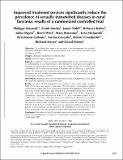Improved Treatment Services Significantly Reduce the Prevalence of Sexually Transmitted Diseases in Rural Tanzania: Result of a Randomized Controlled Trial
View/
Publication Date
12/11/1997Type
Article, Journalviews
downloads
Metadata
Show full item recordCitation
Mayaud, Philippe1,2; Mosha, Frank3; Todd, James1,2; Balira, Rebecca3; Mgara, Julius3; West, Beryl1; Rusizoka, Mary4; Mwijarubi, Ezra2; Gabone, Reverianus3; Gavyole, Awena4; Grosskurth, Heiner1,2; Hayes, Richard1; Mabey, David1,5 Improved treatment services significantly reduce the prevalence of sexually transmitted diseases in rural Tanzania, AIDS: December 11, 1997 - Volume 11 - Issue 15 - p 1873-1880
Abstract/
Objective: To evaluate the impact of improved case management for sexually transmitted diseases (STD) at the primary health care level on the incidence and prevalence of STD. Design: Community-randomized controlled trial. Setting: Mwanza region, Tanzania. Subjects: A random cohort of about 1000 adults aged 15–54 years from each of 12 communities, in six matched pairs. One member of each pair was assigned at random to receive the intervention, and the others served as a comparison community. This cohort was surveyed at baseline and at follow-up 2 years later. About 100 antenatal clinic attenders were also studied in each community on two occasions: the first shortly after the implementation of the intervention, and the second approximately 1 year later. Intervention: Improved services were established for the management of STD, using the syndromic approach, in rural health units. Results: A total of 12 534 individuals were enrolled in the cohort study, of whom 8844 (71%) were seen again 2 years later. The prevalence of serological syphilis (rapid plasma reagin titre ≥1:8, Treponema pallidum haemagglutinin assay positive) was 6.2% in both intervention and comparison communities at baseline. At followup it was 5.0% in the intervention community and 7.0% in the comparison community [adjusted relative risk (RR), 0.71; 95% confidence interval (CI), 0.54–0.93; P < 0.02]. The prevalence of urethritis in males did not differ significantly between intervention and comparison groups at follow-up, but the prevalence of symptomatic urethritis was reduced by about 50% (adjusted RR, 0.51; 95% CI, 0.24–1.10; P = 0.08). There was no significant difference between the groups in the incidence of self-reported STD symptoms over the last year of the follow-up period, or in the prevalence of any STD in antenatal clinic attenders. Conclusion: The reduction in HIV incidence previously reported in this intervention study can be attributed to a reduction in the duration, and hence the prevalence of symptomatic STD.
Publisher
AIDSCollections
- General - GEN [367]

